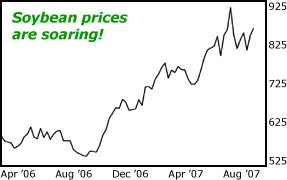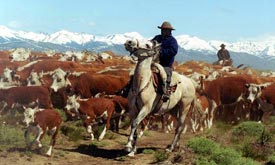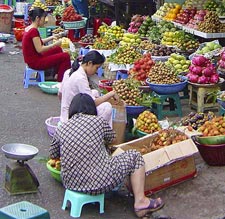The Big Bull Market in Grains
Commodities / Agricultural Commodities Sep 08, 2007 - 09:26 AM GMT

 Sean Brodrick writes: Vampire bats and piranha scare the bejeezus out of me. So I probably won't be visiting an Argentinean cattle ranch anytime soon. See, the Argentineans are emptying out their world-famous cattle lands, driving their herds north into scrublands and swamps infested with vampire bats and piranha.
Sean Brodrick writes: Vampire bats and piranha scare the bejeezus out of me. So I probably won't be visiting an Argentinean cattle ranch anytime soon. See, the Argentineans are emptying out their world-famous cattle lands, driving their herds north into scrublands and swamps infested with vampire bats and piranha.
Argentineans eat more beef — an average of 132 pounds per person per year — than anyone in the world. So why are they driving their beloved cattle into the swamps? Because there's an even bigger bull market at work on the grassy plains of the central Pampas …
It's the same bull market that is driving the cost of U.S. farmland higher when other real estate is sinking lower …

It's the same bull market that is forcing Russia to consider BANNING exports of one of its most profitable commodities …
And it's the same bull market that could prove very profitable for investors smart enough to get in early while Wall Street snoozes.
I'm Talking About the Bull Market For So-Called "Soft" Commodities
In Argentina, an area roughly two and a half times the size of Switzerland — more than 24,710,538 acres of prime cattle country — has been plowed under and planted with soybeans and corn.
Reason: The price of both grains are soaring, fueled by surging demand from China. So it's getting a lot more lucrative for Argentineans to raise beans instead of cattle.
Argentina is the now the world's third-largest soybean exporter, after the U.S. and Brazil. Last year, the country shipped about $9 billion worth of soybeans and soybean products, accounting for almost a fifth of its total exports.
 |
| Argentinean ranchers are moving their cattle to swamps because of rising soybean prices … |
Argentina's changing landscape perfectly illustrates an economic shockwave that is reshaping the global economy. However, this rally in "soft," or agricultural, commodities is still off most investors' radar screens.
The smart money is starting to get interested. Commodity guru Jim Rogers has said that soft commodities are where the biggest gains will be made over the next five to 10 years. And even Rogers could be playing it conservative. Christopher Wyke, from fund manager Schroders, was recently quoted as saying,
"After coming out of a quarter-century bear market in agricultural and soft commodity prices, we are now at year one of a 20-year bull market."
I agree! Here's why …
More Mouths to Feed: The world population passed six billion in 1999, and every year there are 78 million more mouths to feed, according to UN statistics.
At the same time, new middle classes are emerging in China and India, which together have over a third of the world's population. So not only do we have more mouths, we have more mouths with more money.
Meanwhile …
World Grain Production Consumption & Balance |
|||
| Production | Consumption | Surplus or Deficit | |
Million tonnes |
|||
| 1996 | 1,873 |
1,808 |
64 |
| 1997 | 1,876 |
1,820 |
58 |
| 1998 | 1,876 |
1,834 |
41 |
| 1999 | 1,872 |
1,853 |
19 |
| 2000 | 1,842 |
1,857 |
-14 |
| 2001 | 1,874 |
1,900 |
-26 |
| 2002 | 1,821 |
1,910 |
-89 |
| 2003 | 1,862 |
1,935 |
-73 |
| 2004 | 2,043 |
1,990 |
54 |
| 2005 | 2,009 |
2,014 |
-5 |
| 2006 | 1,967 |
2,040 |
-72 |
| Source: Earth Policy Institute | |||
Worldwide, grain production is falling short. That's been the case in eight of the last nine years, in fact. This has lowered grain supplies to the lowest level in 26 years . They continue to fall, and should drop to 114.8 million tonnes by May 31 of 2008. That would be only 67.5 days of supply — the tightest in modern history.
What's the problem? For one …
Crops are being hurt by both droughts and floods. Droughts in Europe will lower harvests in Germany and France by 10%. A drought in Canada means the smallest wheat crop in five years. In Australia, lack of rain is dropping the wheat harvest by 29%. And in the Ukraine, the world's sixth-largest wheat producer, dry conditions are turning 58% of exports to dust.
Meanwhile, both droughts and floods have hammered China, cutting its wheat output by 10%. Hurricane Dean just trampled Mexico's corn harvest. And the impact of Hurricane Felix remains to be measured, but it's probably more bad news for Mexican farmers.
As for the U.S., first drought, then too much rain, hammered corn, wheat and soybean crops.
End result: It's getting tougher and tougher to grow crops around the globe. Those that are brought to market will likely fetch premium prices.
Unfortunately …
Global Warming is making things worse. We can talk ourselves to death debating whether global warming is a natural cycle, man-made, or both. But for whatever reason, the Earth is getting warmer.
And that means tough times for farmers. A recent study showed that global temperatures increased enough between 1981 and 2002 to reduce major grain crop yields by an annual average of 40 million metric tonnes!
Again, this puts more pressure on supplies. Plus …
Demand isn't slowing down … it's rising by 31 million tonnes a year! Overseas orders for U.S. wheat were recently up 77% from a year earlier, government figures show.
Even Iran is buying our corn, and Iran hasn't bought U.S. corn for three years. A flood of overseas orders should keep prices soaring. Speaking of which …
China's hunger for grains is rising above its output. China is a force all on its own. The country's domestic grain supply fell short by 10 million tonnes last year, and despite bumper crops, the problem should get worse going forward.
Thanks to desertification and city-building, farmable land is shrinking in China — dwindling by 19.7 million acres between 1999 and 2005.
 |
| China's hunger for soft commodities keeps increasing! |
China's soybean imports have almost doubled since 2003 - 2004. Imports from January to July rose 2.6% to 16.9 million tonnes. And the U.S. provided 7.8 million tonnes of that supply.
What's more, China's use of corn-based ethanol is shifting into higher gear, putting even more strain on domestic supply. But wait, there's even more …
Russian Grain Embargo Could Knock The World on Its Ear (of Corn)
Over the weekend, we got news that Russia, the world's fifth-largest wheat exporter, is concerned about rising local bread prices and inflation ahead of legislative elections in December.
The upshot is that Russia is considering a ban on cereal exports! This could have massive repercussions throughout the markets. And it looks like the beginning of a trend …
While other major exporters may not be considering outright export bans (yet), they are trying to slow down grain exports. I've already told you how Ukraine's wheat harvest has been decimated by drought. Well, in June, the country slapped prohibitive export tariffs on its grains to try and keep local bread prices from skyrocketing.
As countries line up to take their grain off the market, the bidding frenzy that is already underway will worsen. That's why wheat prices surged last week to a record high above the $8-a-bushel level in Chicago!
The good news? If there was going to be an OPEC for grain, the U.S. would be like Saudi Arabia.
The bad news is that consumers around the world, including you and me, would have to foot the bill through higher and higher prices.
And lest I leave you with the impression that cows are no longer valuable, I should point out that China's population is eating four times as much beef today as it did in 1980, a trend that is accelerating.
Globally, beef imports by major importers should increase about 1.4 million tonnes (27%) between 2007 and 2016. So while the Argentineans may find it more profitable to turn their cattle pastures into soybean farms in the short term, I think they'll be moo-ooving back into beef production in a big way down the line.
I think you get the picture — plenty of soft commodities are going much, much higher, and the potential profits could be enormous.
Get Your Own Piece Of This Bull Market
For the really big potential returns in agriculture, I've picked out six individual stocks and one red-hot ETF that I'm going to recommend in a special, limited-edition report on September 13.
I'll be selling this report, " 6 Stocks and 1 ETF to Ride the Agriculture Boom " — including three follow-ups — for $198, and I think it would be cheap at triple the price. But if you contact us at 1-800-814-3047 and mention my name, you can reserve a copy for the low pre-publication price of $99.
On September 13, I'll rush you a PDF of the report so you can jump on the recommendations just as soon as they come off the press.
In the meantime, take a look at the Fidelity Select Consumer Staples Portfolio (FDFAX) . Formerly known as Fidelity Select Food & Agriculture, it covers the gamut of food stocks, including some great agriculture-oriented stocks.
And just because I'm bullish on agriculture doesn't mean I'm cooling on other commodities. Far from it! If you want a fund that gives you a stake in all kinds of commodities — corn, wheat, aluminum, oil, and more — consider the PowerShares DB Commodity Index Tracking Fund (DBC) .
Yours for trading profits,
By Sean Brodrick
This investment news is brought to you by Money and Markets . Money and Markets is a free daily investment newsletter from Martin D. Weiss and Weiss Research analysts offering the latest investing news and financial insights for the stock market, including tips and advice on investing in gold, energy and oil. Dr. Weiss is a leader in the fields of investing, interest rates, financial safety and economic forecasting. To view archives or subscribe, visit http://www.moneyandmarkets.com .
Money and Markets Archive |
© 2005-2022 http://www.MarketOracle.co.uk - The Market Oracle is a FREE Daily Financial Markets Analysis & Forecasting online publication.


